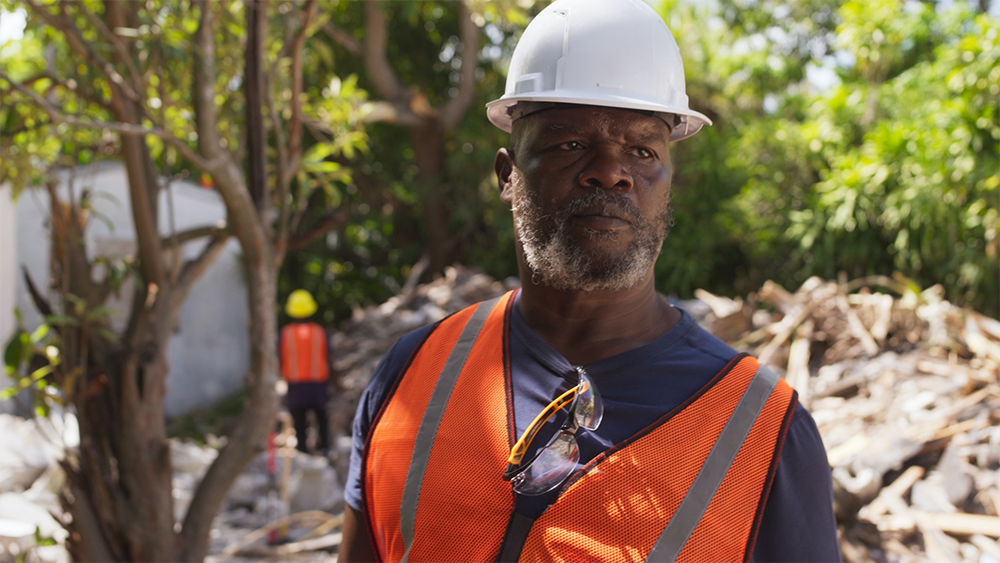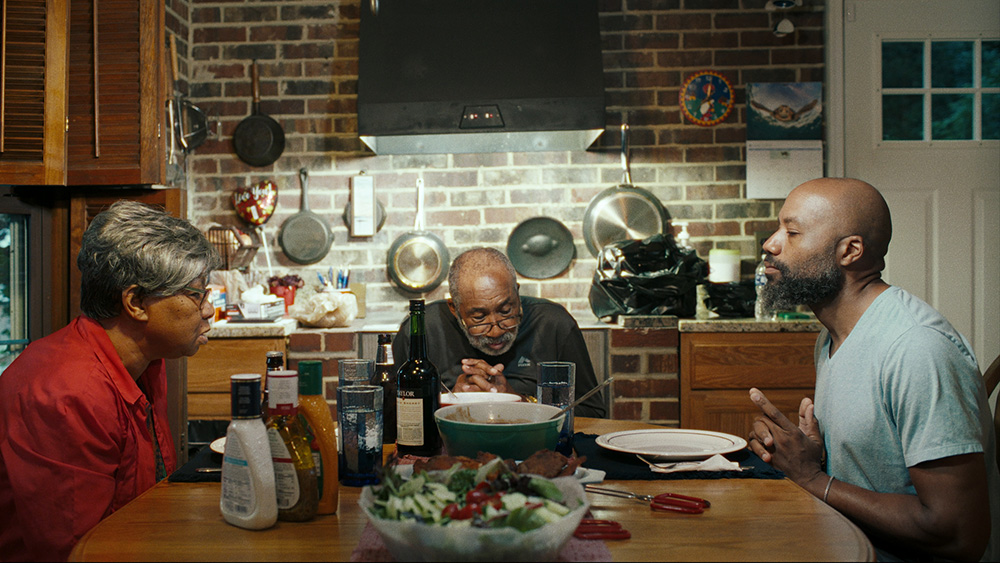
Still from Mountains
A Haitian proverb invokes the title of the film Mountains:“Behind mountains are mountains.” Haitian immigrant Xavier works in building demolition, acutely aware that he is clearing the way for gentrification. When he was in Haiti, he would look at the mountains far away and ask what’s behind them, whereas here in Miami “all you see are buildings.” His crew destroys homes, using cranes that scoop water from a swimming pool and pour over the debris to keep the dust down. Xavier’s Hispanic boss makes disparaging remarks about Blacks, which he tries to smooth over. Xavier wants to buy 226 NW 67 Street in Little Haiti, a bigger one-story white house with a peaked roof, two arched doorways on a corner lot for sale he sees en route home from work. With his beloved wife, who he calls Queen, he goes to an “open house” of the property but they are unsuccessful in their bid. His wife, says “You don’t own anything in this country...You see this house? This is a building. Home is home. Anywhere.” Friends are upset that he is tearing down a 50-year old church (to be replaced by a health center), and he says he shows up to an address, tears down buildings, no questions asked. But when he is asked to tear down the house he wanted to buy to clear the way for a new, larger home on the lot, it’s too much. He takes off his hard hat and walks away, then goes back and watches as they tear down his coveted house while a Haitian parade marches by.

Still from Goodbye, Morganza
Goodbye, Morganza is the bittersweet tale of the St. Joseph’s Housing Project in Morganza, Maryland, a church-based group that enabled Blacks to buy homes after WWII, “A piece of heaven.” The parents of the woman at the center of the film were secretary and treasurer of the project. But a problem arose when taxes weren’t paid, and money was lent for this purpose that turned into a swindle. The family was displaced from their ancestral home. Today, the daughter is moving all the family belongings into two storage units. She sits in a room decorated with Obama “Hope” and Kwanzaa posters.
Dead Girls Dancing are three German teenagers whose high school graduation gift is a road trip to Italy where they stumble upon an abandoned village while looking for help for a flat tire. Turns out, the residents left because of an impending wildfire, which they girls do not know. They make their home in a palazzo, dress up in clothes in closets, and pilfer food from the abandoned grocery store. We get to explore the town along with the girls.
A family compound on Cape Cod is the setting for Somewhere Quiet, when a couple retreats to recover from the wife’s abduction. But things are not what they seem, and the idyllic location becomes an unsettling venue.
In the documentary The Gullspång Miracle, a sister wants to buy an apartment near her sister in a town in Sweden. The place she targets is owned by a woman who is identical to the sisters’ deceased sibling who died by suicide. It turns out they are identical twins, separated at birth in their native occupied Norway to protect them from the Nazi preoccupation with twins who they used for medical experiments. The apartment triggers this awkward, difficult reconciliation.
The music video Someone — I Guess I’m Changing is set in a futuristic work environment, a windowless office painted green with a red area rug, pigeonholes behind, while she stamps white envelopes with “eye” logos. A woman waters identical plants robotically; lies down in a room with white neon rings and reflected colored lights. One envelope she stamps holds a postcard that says “Wish You Were Here” which she carries with her. It inspires her to dance and move naturally, discovering her surroundings. Liberated, she escapes out of the skylight and emerges on a beach with stark cliffs like those in the postcard.

Still from Letter to Rosie
Matt Sanchez writes a posthumous letter to one of his two mothers who died of cancer in Letter to Rosie. They lived in the Bronx, where the film is set, and he is seen in the Westchester Square/East Tremont Avenue IRT station where a vibrant stained glass window “City of Light” by Romare Bearden depicts an elevated train traversing NYC. The artist said, "To see the changing aspects of the city... the great buildings of midtown... and the tenements abutting the elevated lines. Like Edward Hopper, I drew inspiration from these sights.”
Sealed Off also takes place on mass transit, this time in Shanghai during the Japanese occupation (1937-41). Shot in black and white, it give you a clear sense of the city as it was with streetcars and older buildings but then turns to color when we are inside the tram. A man gets on board a train to avoid someone, and starts taking to a beautiful educated woman. There is an attraction, but he is married. The tram is halted because of a military lockdown, but when it starts to move and he realizes he cannot leave his family, the film goes to black and white, and the moment is gone.
Films Mentioned
Mountains, Director Monica Sorelle
Goodbye, Morganza, Director Devon Blackwell
Dead Girls Dancing, Director Anna Roller
Somewhere Quiet, Director Olivia West Lloyd
The Gullspång Miracle, Director Maria Fredriksson
Someone — I Guess I’m Changing, Directors Tessa Rose Jackson and Darius Timmer
Letter to Rosie, Director Ariel Danziger
Sealed Off, Director Tianyu Jiang
